Firenze, 2016
Read on for the story of the trip (essentially as posted in my blog at the time) with some photos. Click on photos to see them full size (click again to collapse them). Or just look at the Best Photos. There are also several other collections (I was lax in my editing so there are too many photos): No Entry Signs, People, Sculpture, Pisa, Siena, the Baptistery, and everything else. There's some overlap between the collections.
Toronto to Boston to Zurich to Bologna to Firenze
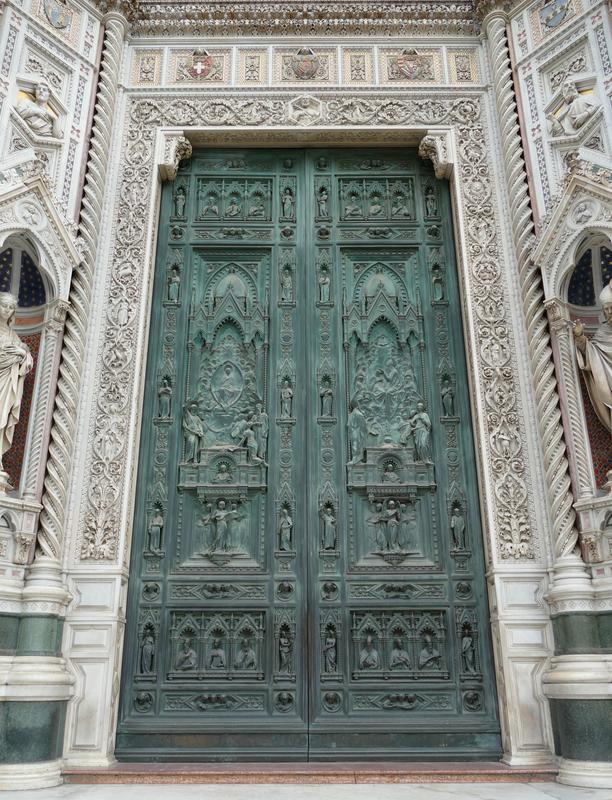
"Firenze" is better known in the English-speaking world as "Florence" in Italy. But come on: "Firenze" sounds so much better! (Remember to pronounce the final "E".) Besides, it's the name the Italians gave it, so let's use that.
My biggest decision after choosing to go to Firenze was what to do about my camera. I have a Canon SX10is that has served me well for seven years, but in the past year it's got cranky about opening the lens when I turn it on. If you tweak the lens gently just as you turn it on ... yeah, let's get a new camera and just not deal with that. I chose the Panasonic FX1000, a superzoom like my previous cameras, but it also has a significantly larger sensor - this makes it more sensitive to light, able to shoot in darker locations. Given that modern digital cameras are essentially a computer that happens to have a lens attached to it, it's also got a number of very interesting tricks up its sleeves. And about 600 pages of documentation spread across two guide books, one paper and one electronic. Best tricks: built-in HDR (High Dynamic Range) multi-shot pictures, and multi-photo night shooting that makes hand-held shooting at night in the city ... easy (for non-photographers: that's major). Worst practical joke (although they didn't mean it that way): if you set the camera to "Silent Mode" (always one of the first things I do), opening the flash won't turn it on. And you'll have no explanation as to why. The fact that this is an issue is explained on page 550 of those 600 pages of documentation, but was initially solved by my co-worker Louis' amazing Google skills. The in-camera panorama doesn't quite work to my satisfaction, so I'm less pissed that it won't work in Silent Mode - and at least it tells you why it's not working, unlike the flash.
I tried out the "UP" - a nifty name, but more comprehensible by its complete name of "Union-Pearson Express." I've always used the Airport Rocket bus from Kipling station, but getting to Union is easier and faster. The UP costs $9 with a Presto card ($12 cash ... but since the TTC is going full Presto as fast as they can, I bought the card), and is much, much more comfortable than the bus. And ... it's got both Wifi and electrical outlets by every seat.
Through foolish booking on my part, I got a grand four airport tour: Toronto, Boston, Zurich, and Bologna. Wait, what? I thought I was going to Firenze? Indeed, bad weather in Firenze sent us to Bologna, where we had a long wait for our luggage along with everyone else who hadn't landed in Firenze, and then on to a large tour bus that drove us to the Firenze airport. This (mis)adventure inspired the passengers to talk amongst themselves, and I ended up spending the bus ride with Bill Cook, a history and art history professor from the Rochester, New York area who also has an apartment in Siena, Italy. And whose world travels make my efforts look like the pathetic beginnings of a novice. So we traded travel stories, and he gave me some tips for the area. I admit to feeling slightly relieved that there were a couple places in the world I'd been that he hadn't (Vancouver Island, Newfoundland, the Maritimes - notice a theme here?), but, just to show how much he's travelled, he's seen considerably more of Myanmar than I have. It's extremely rare for me to meet anyone who's been there at all.
I got to my room around 1700 and cleaned myself up a little, then headed back out for a walking tour of the city - mostly along the Arno. The famous Ponte Vecchio (literally "Old Bridge") has buildings almost the entire way across it, and they're all jewellers. It's also densely packed with tourists.
I went by the Baptistery and the Duomo, distinctive in their multi-coloured marble. The Baptistery is clad in dark green and white, and the Duomo and its Campanile in dark green, white, and pink.
I had dinner at Il Contadino, where I had "Pasta with Wildboar (sic) sauce," "Sausage and beans," and roasted tomatoes. That was a lot of food: as the Rough Guide promised, basic, cheap, and pretty good. And now for an early evening to catch up on my sleep.
photo: "Rape of the Sabines" by Giambologna, one of the sculptures in the loggia in Piazza della Signoria

Piazza del Duomo (Day 2)
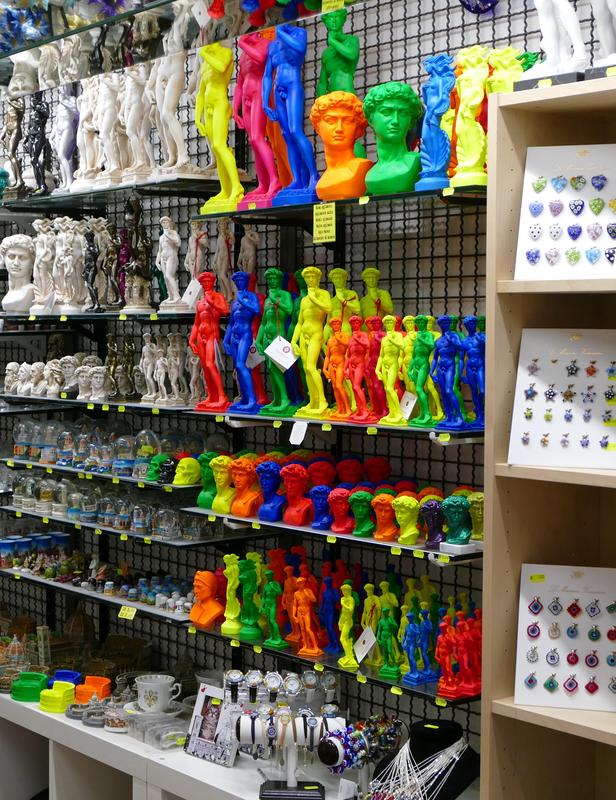
The B&B room is large (at least by European standards), very high ceilinged (which is actually a bit strange feeling for me), and incredibly quiet. The breakfast they served was ... okay. I found the toaster particularly fascinating: you press a plunger to turn it on, but when it pops it doesn't move the toast up: you have to lift out a metal frame, one for each piece, that has a handle that sticks out above the toaster. But that's not all that makes this toaster special: it never visibly heats up, although it does get hot. And because it's not really all that hot ... it takes a long time and produces something closer in consistency to melba toast than what we think of as "toast." Makes it hard to butter because the bread doesn't hold any heat once it's been dehydrated. But yogurt and cereal, and tea and coffee.
My first destination of the morning was The Accademia, the home of what's known as "The David." I found some of my Bologna-detour companions in the timed entrance line (as opposed to the "wait-it-out" line, which was much longer and is known to last several hours). Their tour guide was very helpful, and said you really do want to get the timed entrance ticket online, "then print it out or bring it on your phone." I don't have access to a printer and I left my phone behind as it's no better than a boat anchor here ... except for online tickets, which is really big here. Who knew! So I'll deal with that tomorrow.
Up next was the intensely popular Piazza del Duomo. I found out where to buy tickets for the main attractions: the dome, the Campanile, The Baptistery, Santa Reparata, and the Museo dell'Opera del Duomo - all one ticket, €15 (valid for 48 hours). "Duomo" means literally "Cathedral," but it took me a while to figure that out because it's close to the English word "dome" and here, the Duomo is inseparable from Brunelleschi's massive dome that tops the Duomo. Entrance to the Duomo itself is free.
My first choice of places to visit was to climb the dome itself, before I'd gone into the church. I'd already noticed that the timed entry line to the Dome was a lot shorter than the other line ... so I used the machine at the ticket office to say "I want to go in at 10:30" (it was already 10:25). In fact I got in around 11:00, but spent my time in line well by chatting with a couple guys who live near Nottingham in England, and three Torontonians. And - despite the wait - we did get in very much faster than the other line. The Dome climb is (if the Rough Guide is correct) 463 steps. Narrow twisty steps, half of which are also the way back down so you keep having to squeeze over for people coming the other way. But half way to the top you get to do a semi-circle around the inside base of the dome to look at Giorgio Vasari and Federico Zuccari's "The Last Judgement" which includes many images of Heaven ... but the ones of Hell are rather more eye-catching. This is, you'll understand, a very, very big painting as the dome is 45 metres across. And then it's back to the stairs, up more twists and turns to the outside top of the dome and fine views over the whole city of Firenze. The only thing of the same height anywhere near is The Campanile, which stands right next to the Duomo. On the way back down you do another half-turn around the inside of the dome - this time about 10 metres higher than last time.
I wanted to see the inside of the church whose dome I'd just climbed, so the Duomo was the next stop. There's a 5-10 minute wait to get in at mid-day. Large parts of the church are out of reach to visitors, who follow a U-shaped track in the side door at the front, down to the altar, and then up the centre and out the central doors. It's a massive and mostly empty place, with the Dome probably being the most impressive feature. I would have loved to see the chapels at the sides and back, but those were off the tour.
Near the exit is a set of stairs going down. I assumed that was to a crypt, and it is, but only sort of. Excavations down there have turned up foundations to a previous church (Santa Reparata), including tile flooring dating back well over 1000 years and a number of tombs they hadn't even known existed.
Surprisingly, there was no line for the Baptistery. It's an octagonal building, and the oldest building in the city: it used to be the main cathedral. The marble cladding that matches the Duomo and Campanile is newer. The interior of the roof is nearly as spectacular as the dome, although not quite so large: it's tiled with religious stories, but about 50% of the tiling is gold (at least in colour - I don't know if it's the real thing or not ... the effect is certainly impressive). I sat down and relaxed - and of course took photos.
The outside of the Baptistery has some great works of art on it: the south doors by Andrea Pisano tell the story of St. John the Baptist in 28 panels, but it's Lorenzo Ghiberti's east doors that are even more famous. They're called "The Gates of Paradise" and they're fantastic. Although ... the ones on the Baptistery are copies, the real ones are in the Museo (coming up shortly). But I've loved those doors for years and years: Grace Cathedral in San Francisco has a copy too (photo), and it's great stuff - so I was really looking forward to seeing the real thing.
It just struck me that Rodin's "The Gates of Hell", another favourite sculpture of mine, was very likely riffing on Ghiberti's "Gates of Paradise." Wikipedia confirms this - cool.
Then I went and did what my own planning notes instructed me not to do: I climbed The Campanile in the same day as the Duomo since the Duomo hadn't had any lasting effects. The Rough Guide says the Campanile is 414 steps - although I think you end up slightly higher in the air. Again, narrow stairs, and everyone coming down is using the same ones as the people going up. The Rough Guide was correct about another thing: the view from the Campanile is slightly better, simply because it includes the Duomo. It was fun working out what things are from up there when I haven't been to most of them: I spotted Palazzo Pitti (it's gigantic and pretty obvious). What's surprisingly hard to find is the Arno River: it's well hidden by the buildings that line its shores, even though it's only 10 or 12 blocks from the Campanile.
I moved on to the Museo dell'Opera del Duomo, which holds a great deal of the art that used to live in (and more often "on") the Duomo, and also some from the Campanile(?) and the Baptistery. The highlights are "The Gates of Paradise" and Michelangelo's "Pieta" (he did four "Pietas" in his life - my favourite is still the one in St. Peter's in Rome, possibly my favourite sculpture by anyone). This particular one includes him: https://en.wikipedia.org/wiki/File:Michelangelo_Pieta_Firenze.jpg (the old man at the back). But the whole place is great, I was in there three and a half hours.
By the time I exited, I was in need of dinner. So I went to Yellow Bar, where I got a very good ham and gorgonzola calzone, a glass of Chianti, and eventually a Millefoglie (similar to the French Mille-feuille). It was a good way to end the day.
A couple things that are very common in Firenze (and not related ... I think). The smell of leather, because there's handbag, belt, and/or jacket stores every single block - in this weather, they usually have their door open. And guys in camouflage with machine guns - often seen standing near military grade SUVs with snorkels. Both of these things are commoner in the centre of town, but a couple of the soldiers are stationed, 24x7, half a block from my B&B guarding an entire barricaded block - that turns out to contain the American embassy.
photo: there are an amazing variety of leather vendors outside the Central Market
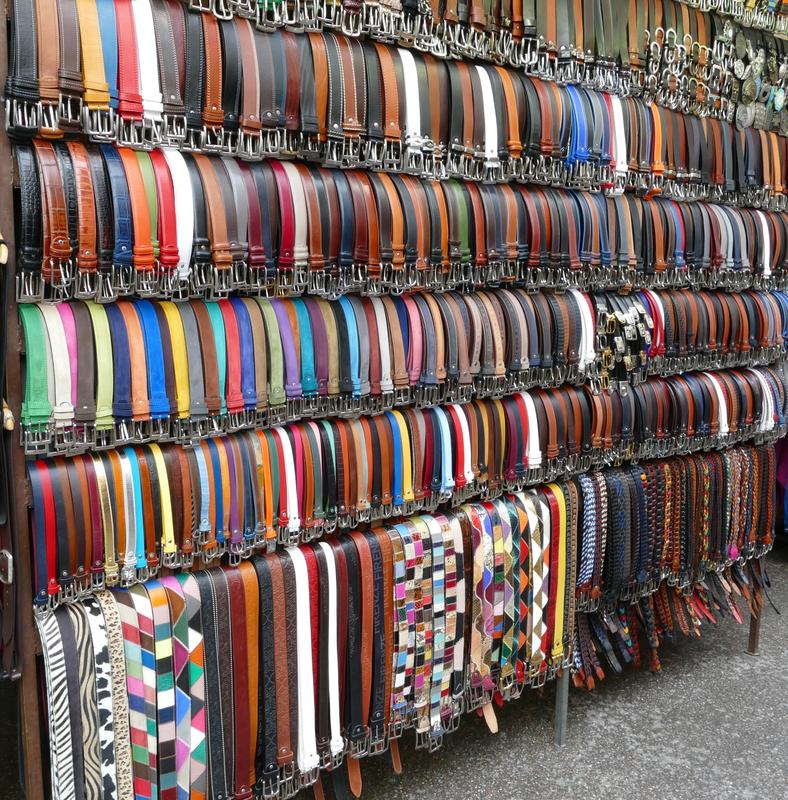
Day 3

Got up late this morning, spent a fair chunk of time after breakfast arranging a couple places that needed to be booked in advance: the Accademia and the Capella Brancacci inside Santa Maria del Carmine (with thanks to my B&B hostess who made the phone call for that one). That's the Brancacci Chapel, which has a rather well known fresco by Masaccio, including the Expulsion of Adam and Eve from the Garden of Eden. I'm guessing you'll recognize it: https://en.wikipedia.org/wiki/Expulsion_from_the_Garden_of_Eden .
I wanted to go to Museo Nazionale Alinari Fotografia (which I found in the Rough Guide). I also wanted to go to the brand new Museo Novecento, which I found in Lonely Planet. Except ... it registered this morning that they're both at the same address: and neither guide mentions the other museum. I correctly guessed that the perpetually out-of-date Rough Guide was in the wrong: the Photographic Museum died (and didn't get sent anywhere else, so I can't see it at all) about two years ago, and in its place we have a new museum of recent Italian Art. I love almost everything about the Rough Guides, and I dislike many things about Lonely Planet: but being up-to-date counts for a lot in the travel guide business. On most trips with a Rough Guide, I'll find about two restaurants a week that have ceased to exist: rarely a problem with Lonely Planet. It's very frustrating.
Museo Novecento: I'm a big fan of "modern" art, which means - approximately - anything from about 1850 forward. But like any art, it's a crap shoot whether or not you're going to like what you see. Novecento is a mid-sized gallery with purely Italian stuff from all through my time range, but I'm afraid that it was a bust for me - only a few pieces I kind of liked, and nothing I loved.
Across the street is the very large Santa Maria Novella church complex: a church, a bunch of buildings that were once a Dominican monastery(?), three cloisters(!), a museum, and catacombs. The first thing I noticed on the way in was that the green and white marble facade on the front of the church was precisely that: one layer of marble facing the square, and the entire rest of the building behind it is rough brown stone. Inside is another very large, fairly empty church, with Giotto's famous crucifix (a large cross-shaped painting rather than a sculpture) suspended in the nave. While preparing this and reading up in the guide book, I find that I casually ignored what are considered some of the greatest works of Masaccio, Filippino (not Filippo) Lippi, and Domenico Ghirlandaio as I toured the church: apparently they didn't strike me as particularly noteworthy. Oops. And surprisingly, even the two cloisters we could get into seemed somewhat ratty to me - the trees were dying. The third cloister, the "Great Cloister," was visible but closed to us.
The city was threatened with some percentage of rain yesterday, but it never materialized. The weather report suggested much the same percentages today, but the rain showed up around 1400 - light, but accompanied by some impressive thunder. I was happily still in Santa Maria Novella, and enjoyed sitting in one of the cloisters watching the rain fall.
My next destination (this probably sounds all carefully planned to you, when in truth half of it is me going "oh, that's open and I'm here") was the Capella Medicee. The Medici ruled this city for several generations, and they were exceedingly rich. They don't seem like they were particularly nice people, but they were huge patrons of the arts. The chapel entrance includes a metal detector, the first time I've seen one of those. When I emptied my pockets, they politely snagged my Swiss Army knife and gave me a number to pick it up on the way out.
The first part of the Medici chapel is an incredibly dour place, done - rather spectacularly, I admit - in several shades of very dark marble, and with massive, over-wrought sarcophagi embedded in the walls over our heads. It was extremely ostentatious, but also a lot of fun to look at. But it's also not the reason that most people walk through the doors: that comes in the next room, the tombs of ... ah, I don't remember their names. It doesn't matter - they weren't the important Medicis. What matters was that two of the tombs were entirely sculpted by Michelangelo, and he had a hand in the third as well.
I had a Michelangelo epiphany in Rome: I hadn't quite "got" his Moses from the photos I'd seen. But in the presence of that sculpture ... wow, it's brilliant and even a little scary. He's a really big guy, and he looks like he's about to rocket out of that chair. ( https://en.wikipedia.org/wiki/Moses_%28Michelangelo%29 ) I mention this because ... I didn't get that effect with these sculptures. Moses had left me believing anything is possible with Michaelangelo, but it didn't happen here. There's still "the David."
I think I want to go back to Rome - to see Moses and the St. Peter Pieta again, and to see the Bernini Museum.
The last stop of the day before dinner was San Lorenzo. The ticket office leads you to the museum under the church first, and there I was reminded that the Florentines seem to have a particular fascination with reliquaries and relics. Like, bits of dead saints. It's kind of gross: they make these incredibly ornate gold and silver and glass boxes and cylinders and chalices to hold pieces of bone, clumps of hair, and various other unidentifiable bits. The times you come across fingers - complete with shrivelled skin - makes you wish they'd stuck with "unidentifiable." San Lorenzo has something like 15 or 20 of these on display, and most of the churches I've seen here have several of their own - although this collection was the largest so far. They also have a really lovely cloister with an orange tree in full fruit in the middle.
photo: Reliquaries in the Capelle Medicee (the Medici Chapel)
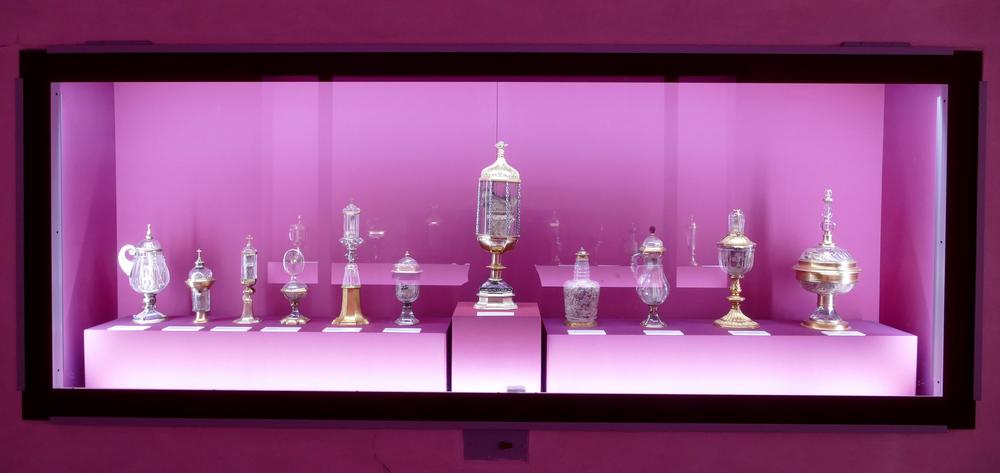
And at last up the stairs to the church. I'm afraid I've chosen my visit to Florence as the time to burn out on Medieval religious art: not exactly optimal. San Lorenzo is full of epically large paintings in bays along the walls, and a couple were fairly striking, but none really sparked my enthusiasm.
I then visited Carabé Gelateria, where I got the Rough-Guide-recommended cannoli. It's going to be a LONG time before I eat that stuff Toronto Italian bakeries use that name for again. So incredibly good.
On the way back to my B&B for a short break I stopped in at the Mercato Centrale cafeteria/food market. There's a full scale food market much along the lines of Toronto's St. Lawrence Market downstairs, but it's closed by 1400 or so - certainly before I arrived. But the shops selling prepared food and wine upstairs remain open well into the evening with a large and talkative crowd. Cool place: I hope to go back and sample later.
After a break at the B&B, I made my way to a Lonely-Planet-recommended restaurant, Trattoria Marione. I ordered the pasta with butter, parmesan, and black pepper, with a side of "peas and ham" and a glass of the house Chianti (the regional wine). This was a fairly mixed blessing: a plate arrived on my table with thick noodles in white sauce, but no cheese or black pepper. And I couldn't get a server's attention for the life of me. Somehow parmesan magically appeared on my table, but I eventually borrowed the black pepper from the people next to me. Then the side showed up, and they'd used canned peas - ugh, couldn't you at least use frozen, which tastes approximately like the real thing? The noodles were incredibly thick (4mm?) and chewy, and once topped with cheese and pepper, were really excellent. And the tiramisu I had for dessert was possibly the best I've ever had, even eating it four or five nights straight in Rome. The service, however, was a bit shaky.
A walk around town in the evening produced what I hope will be some good photos: the caricature artist you see above waiting for business, and the Ponte Vecchio at night below were both from this stroll.
photo: the Ponte Vecchio bridge

Day 4

My first stop of the day was Santa Maria del Carmine, in Oltarno ("the other side of the Arno") - the first time I've really ventured over there. The church itself is for the most part fairly traditional, but I was overjoyed to see they had a trompe-l'oeil ceiling ( https://en.wikipedia.org/wiki/Tromp_l'oeil ). Roman columns and arches extend upward above you ... but the middle of the ceiling opens up to heaven. I love those things.
One of the side chapels is cordoned off: this is the Capella Brancacci, for which you go out the church door and through a side door past the ticket office (the church itself is free). I had a timed entry that my B&B manager helped me get; I seemed to be the only person who'd called ahead. But they were under quota so everyone got in. My guidebook compares the Capella Brancacci to the Sistine Chapel in importance, and even I can understand that when it's pointed out that Masaccio's "Expulsion of Adam and Eve" shows real human emotion as never seen before in the period - with Adam stumbling out with his hands over his face and Eve wailing.
Something else I noticed: when you get up close and at an angle, the light reflects off bumps and bulges, showing that the people in most of the big scenes have had at least one facial reassignment surgery. This is indirectly discussed in some of the church documentation: faces were literally removed and re-added later. But I suspect it was more than that, and had a lot to do with politics, as churches are constructed over hundreds of years and dynasties rise and fall, and the person who plays the part of the rich merchant in the fresco is no longer in favour and so is scraped off and replaced by the new person who's footing the bills. But this may just be my over-active imagination.
On the way to the centre of town, I stopped at a store called Alberto Cozzi that Lonely Planet mentioned sells marbled paper. They do a bit more than that: they marble the paper themselves, they bind (and re-bind) books, and on Saturdays they have demonstrations of how to make marbled paper. I'm very interested in that: I've been fascinated by marbled paper since I went to Venice in 2002. I bought five sheets then and expect to bring home at least a couple more. I spent a lot of time trying to recreate the marbled paper process in The Gimp (one of Linux's several image manipulation software packages), but with only limited success.
Next up, Orsanmichele. This is a looming shoebox of a building right in the centre of Florence. Lots of sculptures on the outside - but they're all replicas now because the originals are in the Museo di Orsanmichele ... which is only open on Monday. Aside from the sculptures, the building gives none of the usual indications that it's a church: I don't recall a cross, and there certainly isn't a peaked roof or spire. It's just a very tall brick of a building that's impossible to photograph because it's not on a piazza, it's just packed into Firenze's narrow streets like any other building. The centrepiece is a huge tabernacle (I'm taking that word from the Rough Guide - I assume they're right), a structure in an area that might usually be the choir, that holds a painting of the Madonna.
Upstairs in what apparently used to be the grain silos (this church has an interesting history) is the museum with all its sculptures. Evidently they were by famous people (Ghiberti, Verrocchio, Brunelleschi, Donatello) but again, none stood out to me ...
photo: Looking out from Orsanmichele
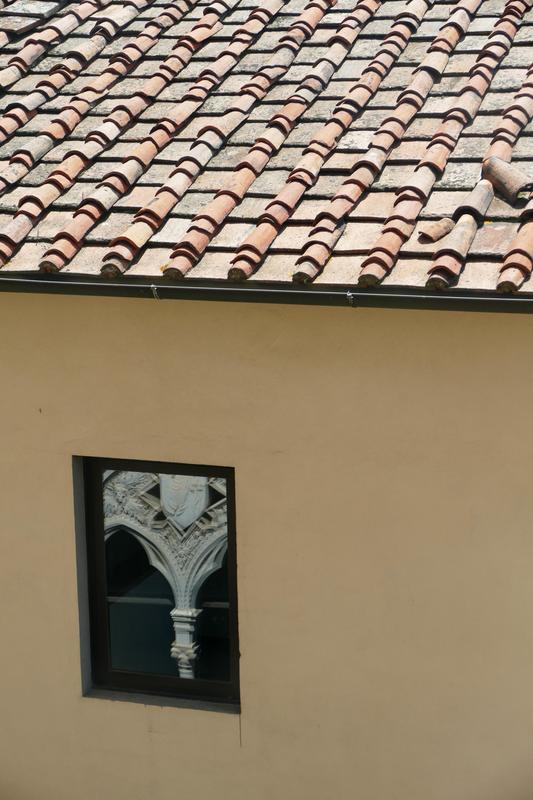
Palazzo Vecchio is the fortress-like building in the centre of town that I think still serves as the city's town hall - but also houses a number of medieval apartments-turned-museum - preserved much as they were, although with less furniture - and it also has a more traditional museum. The apartments seem to have been mostly the product of the Medici again, and the many, many artists they employed to paint and decorate the walls and ceilings. It's spectacularly ornate, and more than a little gaudy. I found several illustrations of Hercules, including two apparently by different artists, in two different rooms, of him battling the Hydra.
The attached museum is surprisingly small - only five or six rooms - and didn't particularly register on me.
But then came another fun part: Palazzo Vecchio has a tower, and you can climb it. So of course I did. More nice views of the city - and this time you can see the Arno - you're lower down than at the Dome or the Campanile, but you're also closer. The Arno is just beyond the Uffizi - the other really famous museum I haven't visited yet (that and the Accademia, which I'm booked into tomorrow).
Next was Badia Fiorentina, another nice church - and we're visiting today because it's only opened by volunteers from 1500 to 1800 on Monday. And hallelujah, we have a piece of medieval art that I liked: Filippino Lippi's "Apparition of the Virgin to St. Bernard" was very nice. And the attached Orange Tree Cloister is really lovely - it's two storeys, although only the upper one is open to the public.
It was getting late in the day, but I risked going to the Galileo Museum. I should know better than to enter a science museum with an hour and twenty minutes until closing, but I did okay: all those fabulous astrolabes, sextants, telescopes, microscopes, and gorgeously worked demonstration equipment (with woodworking you don't see on furniture these days, never mind on what amounts to school equipment).
Dinner was at the multi-personality Fiaschetteria Cambi ... that's what it says on their menu. But I came in the door that said "Antico Ristreto di Cambi" (sp?), and not the one that said "Trattoria." My only complaint about the place was that nearly all the seats are stools: not ideal for the back when you've just spent eight hours walking. I had an "Aperitivo Prosecco," then "Penne gorgonzola e asparagi" (you can probably figure that one out) which was really good. For dessert I had "Sfogliantina di mele con la creme calda," which my waitress was kind enough to translate as "(apple) strudel with fig jam and hot cream on the side." Also very good.
photo: a wall sculpture at Santa Maria del Carmine church
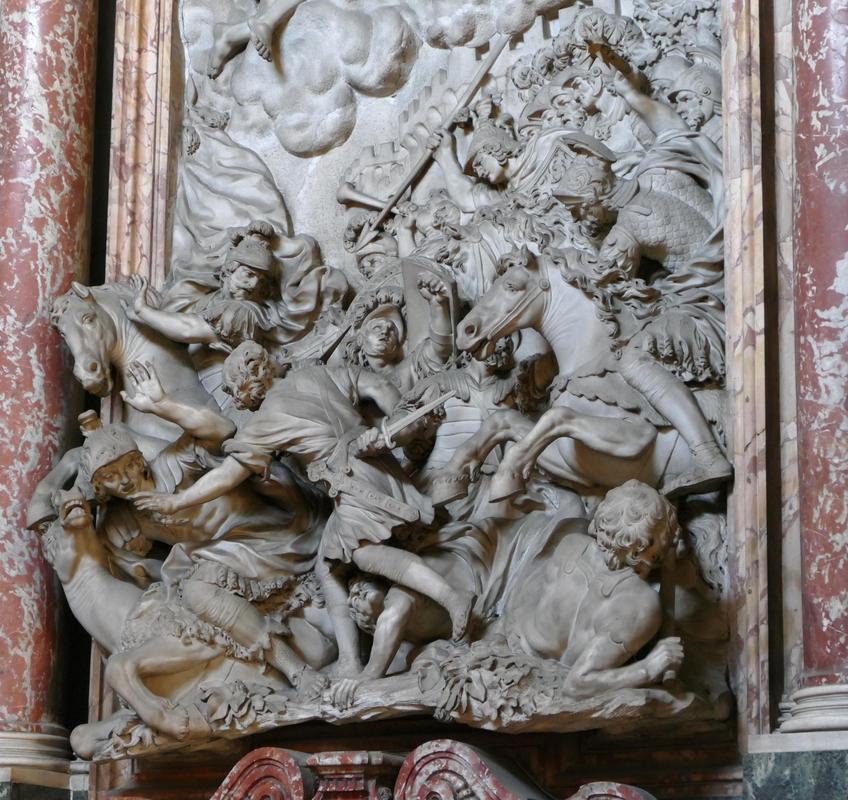
The David
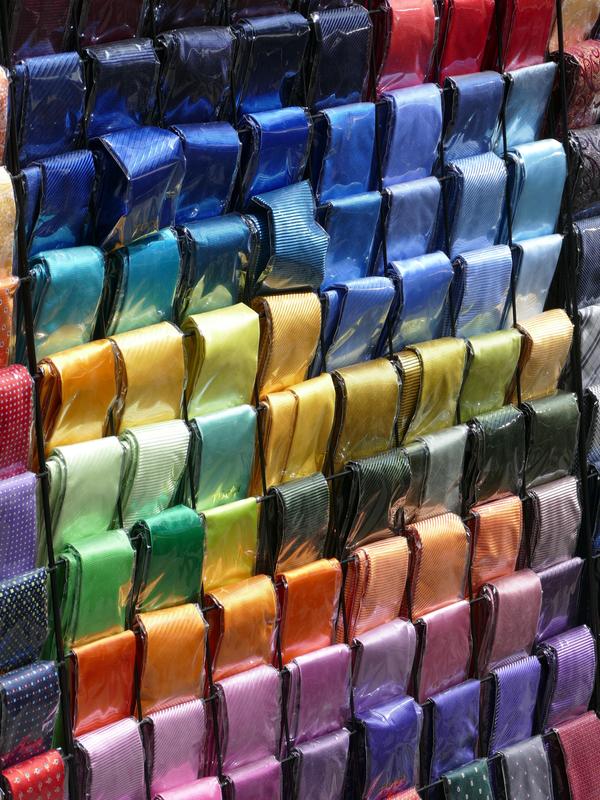
I left the B&B early this morning to make a run for the Uffizi, but I'm not good at early mornings so I still didn't get there until around 0845. And the line-up was already looking pretty painful, so I passed. That led me to my alternate, which was the Bargello. The Bargello is only a few blocks away, and draws a fair crowd - but it's second tier compared to the Duomo, the Accademia (with "The David") and the Uffizi. It's only a "second tier" museum because it's in the same city as the Uffizi and the Accademia: its collection is very good. Lots of Cellini, plus some Giambologna and Donatello. The Rough Guide mentions three works by Michelangelo, of which I spotted precisely none. I didn't ask and probably should have. The museum also has some small and finely detailed religious ivory carvings (surprisingly, I like those - something about miniatures I suppose), porcelain, a small room of Islamic art, etc.
My next stop was the Mercato Centrale, a place much akin to Toronto's St. Lawrence Market. It was interesting to see the produce on display: I almost always enjoy food markets for this reason. Then I headed back upstairs to the prepared food stalls I'd seen a couple days ago, which are much less busy this early in the day (it was 1030 or 1100, as opposed to around 1800 last time I was there). I chose the place that made pretty much everything with truffles: I had a frittata-truffle sandwich and a ham-truffle sandwich - each only €4 and a great deal better than I expected: I would definitely recommend them. A wandering waitress from another booth asked me if I wanted a drink, so I got a cappuccino. After that, I bought a cannoli at another stall: not so good as Carabé's, but still quite nice.
From there to a museum literally around the corner from the Accademia, the Museo dell'Opificio delle Pietre Dure. "Pietre Dure" is not - as I kept misremembering - a person, but rather a process: that of creating pictures with polished inlaid semi-precious stones. Hey, it's rocks. I like rocks. Although it turns out, as much as I like rocks and the vibrant colours they sometimes have, there are some poor uses for those strong colours. Malachite, for example, is a spectacular shade of striped green ( https://en.wikipedia.org/wiki/Malachite ), and small pieces of it are very lovely. This museum had an entire fireplace made out of malachite, and I found that overwhelming and just garish. The art they do with inlaid rock is (sometimes) utterly gorgeous. Its biggest failing is much along the line of the fireplace: there's very little control of gradation of colour, no subtlety. But at its best, it's very beautiful indeed.
I dropped by the nearby Cenacolo di Sant'Apollonia - apparently "Last Suppers" are something of a Florentine speciality, and that's what's on display here - a "Last Supper" by Andrea del Castagno (that's all there is to see). I'm afraid that my mind went in a rather irreverent direction: all the guys on the far side of the table have golden frisbees over their heads, why doesn't the black-haired, black-bearded Judas on the near side of the table have a frisbee? And why didn't anyone notice?
San Marco Church and Spedale degli Innocenti share a square nearby, but my luck wasn't too good: San Marco is closed for about three hours mid-afternoon - a window I managed to hit - and the Spedale is in the midst of renovations that have closed its two evidently lovely cloisters until mid-June. And then it was time for my appointment with The David at the Accademia: I had to pick up the timed-entry ticket I'd paid for online, which also allowed me the opportunity to buy a timed-entry ticket for the Uffizi on Saturday. The Accademia timed-entry ticket allowed me to walk straight in (usually you have a 5-10 minute wait, even with the timed-entry), which was great. I went first to their temporary exhibit on Carlo Petrelli, a medieval painter. And then to the hall with five unfinished Michelangelos (one is disputed), but towering down the end of the hall is the man you've all been waiting for, David. I find it fascinating that Michelangelo's roughed out, incomplete sculptures are given a place of more importance in a museum than the best works of lesser sculptors. And I'm a bit surprised to find that I sort of saw why. But it's David that's the reason we're here: and damn, that's a brilliant piece of work. I spent about ten minutes walking around him and taking photos, then went off to look at the second floor - religious art of my least favourite kind: altarpieces, triptychs, diptychs, panels, and every single one dipped in gold leaf. That didn't hold my attention long. Then back to David. I found a seat, and sat there about 45 minutes. Seriously, it's extremely unlikely I'll ever see this sculpture in person again. The detail is spectacular, perfect. So yes, this is one I "get."
The Bargello is in possession of multiple "David" sculptures, two by Donatello, another by Verrocchio, possibly more. But its main competitor for me is the one by Bernini that's up in Rome.
I have to add a note of respect for the way the museum has chosen to display David. There's lots of light from a huge frosted dome window overhead, and you can walk all the way around him. He's also at exactly the right height, with his feet perhaps two metres off the floor, meaning that everyone can see him quite clearly and will only have to wait a few seconds for enough space to take the picture they want - despite the ever-present crowds.
On the way out, I visited the small but interesting musical instrument museum. They have four or five Stradivarius instruments, which surprised me: most Strads are usually in the hands of world-class musicians (and HEAVILY insured) because it's better for them to be played. I was very entertained by the two basses they had on display (not Strads, I think): one had three strings, the other five (and in each case it was what they were designed for). Between the two they average out to what we expect these days. They also had two ebony harpsichords (one a replica of the other). Ebony was and is a very expensive (and hard to work) wood, so this is a little like making your brass instruments out of silver. Unfortunately, they didn't say what it sounded like.
I decided the next stop was Il Torchio - a marbled paper store - again in Oltarno. On my way to the west before crossing the river, I noticed a small place called "Oil Shoppe." I remembered that one of my guides had recommended it (turned out to be Lonely Planet) and I was hungry, so I stopped in. Despite the odd and (to my mind) not very encouraging name, this is a sandwich shop. I ordered a #30 panini (from the all-English menu - it took a moment to register that that's unusual): chicken chunks, fried egg, roast pepper sauce, carmelized onion, spinach, and garlic mayo. It was a few minutes because each sandwich is made to order. It cost €4.50. Understand: in the main tourist areas, cold sandwiches (not hot, like this one) are sold pre-made with maybe one topping (two if you're lucky) for €6, and - although I haven't tried one - they ain't this good. My only complaint - and it won't be fixed in this country - is the dryness of the bread: I like French bread, crusty outside, chewy inside, but Italians like their bread dry (and in this case it was toasted to boot). But damn, that was a GOOD sandwich. I also got onion rings: thick pieces of heavily battered onion, much doughier than we expect, and a bit salty (but in a good way). And some iced coffee: too sweet (and I don't often say that) and too much dairy, reasonably tasty but I probably wouldn't order it again. Sadly Oil Shoppe is in the east end and I'm in the west end so I may not have much chance to go back for those excellent sandwiches.
Il Torchio has some excellent marbled paper, and some nice leather-bound and marbled books of various sorts.
On the way back to the B&B I visited train station. The train to Pisa leaves every fifteen minutes or so, so I'm not even going to worry about it: I'll just go to the station when I want to go. The plan - contingent on the weather - is to go tomorrow. I also found the well-hidden bus station (it's a driveway and a couple small pedestrian walkways into a poorly marked building) and got a bus schedule for Siena, the other out-of-town destination I'm planning on visiting. Those leave every half hour.
photo: "The David"

A Pisa Day Trip
I wanted to mention something that happened at the Pietre Dure museum yesterday. I could see through one of the windows that they had a big rock heap in the courtyard (they still practise what they display), and I wanted to go see it. But the courtyard was marked as private. So I asked at the front desk if I could go in and take a few photos. The guy came out from behind the desk, walked over to another guy who looked like his job was carrying those rocks around, and asked him something in Italian. The response was possibly the world's most emphatic "No" in word, body language, and added sound effect - it was fairly impressive. The first guy gestured at me, said a couple words, and the other guy looked me over, then beckoned me to come with him into the courtyard. WTF? I'm not complaining, but ... so ... Italian.
Another "common thing" around here (to go with the smell of leather and the guys with machine guns previously mentioned) is street vendors selling selfie-sticks in a rainbow of colours. They're near every major tourist destination, and their product haunts all of us wherever we go. When it rains, they magically reappear clutching umbrellas for sale.
I got to the train station around 0845 this morning and noticed there was an 0853 departure to Pisa. I didn't make that one (didn't expect to), eventually got a ticket on the 0928. What the ticket guy didn't mention was that the final destination was "Livorno," not "Pisa," so that's how it showed up on the Departures board - took me a while to figure that one out. Don't forget to validate your ticket on the platform! The ride is slightly over an hour, and quite comfortable (only €8).
Pisa Centrale (the train station) is about a kilometre walk from Piazza dei Miracoli, which is where all the big tourist attractions (including the tower) are. I walked around the Piazza with its meticulously groomed lawns, admiring the gorgeous Duomo (Cathedral), Battistero (Baptistery), Camposanto (we'll get to that), and - of course - the tower. I was gobsmacked by the number of people with their hands out, holding up open air for their camera-equipped friends: apparently that's a joke that just doesn't get old for most people. I think I saw one person who was pushing the tower over instead of holding it up - that's something, I guess.
I want to talk about the tower because it fascinates me. (This is paraphrased from Lonely Planet and is likely even less accurate than that source.) Its purpose in life was to be the bell tower for the Duomo - surprisingly, it apparently still fulfills that role (happily not while I was standing next to the bells). But the choice of location was poor, and the tower began to tilt because of swampy soil before it was half built. Construction took generations. The second architect had a shot at fixing the tilt by making the tower ever so slightly banana-shaped (I didn't notice it in person, but I can definitely see it in the pictures). The tower was completed, but as the centuries passed, it settled further until it was leaning at something in the neighbourhood of five degrees. This was a little too much, so the building was closed, massively counter-weighted, and a decade-long project was instigated to straighten and stabilize the tower. This was completed a bit more than a decade ago, with the tower now leaning at a comfortable 3.8 degrees or so. It's a lovely building in its own right, but it's the tilt that's made it the world-renowned landmark it is today.
photo: The Leaning Tower
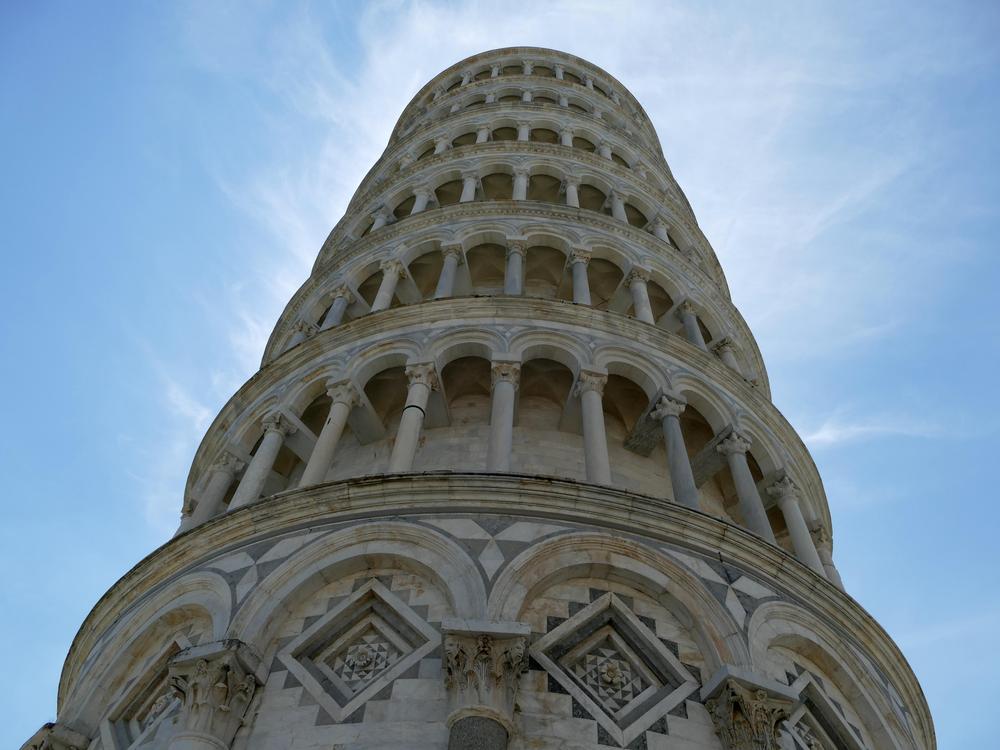
You can climb the Leaning Tower. If you're reading this, you know I had to. €18 timed entry, and you have to leave your bag behind - although you can of course take your camera. Even stepping into the building is disorienting, something I hadn't expected. The main floor is, not surprisingly, as off-kilter as the tower. I didn't expect four degrees of tilt to be particularly noticeable, but it is. And it gets even weirder when you go up the stairs, as you spiral from tilting one way to tilting the other and back again on worn and slippery stone steps. At the top, the world seems alarmingly close on one side.
The views are great: while it's only 58 metres tall, the Leaning Tower is by far the largest structure for miles (okay, the Duomo's Dome comes close, but nothing else does). I stayed up there half an hour or so, enjoying the perfect weather and the views.
The Camposanto has a weird history: local medieval worthies had themselves buried in ancient Roman sarcophagi, and/or borrowed Roman headstones etc. The Camposanto collected all of these into one place, a very long rectangular building - essentially an enormously long cloister lined with graves and sarcophagi. Bizarre, but actually really lovely and peaceful (and a break from the very busy Piazza). There are lots and lots of frescoes, most in pretty serious disrepair. One is particularly famous, showing as it does the tortures of sinners in hell - it's also in somewhat better shape.
Several years ago, I was struck by a sarcophagus (in the intellectual sense, not the physical) in Prague that was simultaneously beautiful and vastly self-aggrandizing. The person who had this commissioned thought exceptionally well of themselves. A gorgeous young girl was sprawled across the sarcophagus, weeping at the loss of this person for all eternity. I hadn't seen the like until today, although the two or three here that included young women at the grave-side didn't have them sprawled weeping over the sarcophagus - none were so blatant as that. But you gotta think really well of yourself to believe this is a good memorial ... Of course, it could be your family that arranged it, who knows?
A surprise find was some guy by the name of Leonardo Fibonacci - and given that the grave (no weeping girl, but a large statue) mentions "Matematico," I think he's the one I'm thinking of. Very cool. (Wikipedia confirms this.)
P.S. Lots more reliquaries.
My next stop was the Battistero, a gorgeous round and rather tall building. It's mostly white marble, and heavily decorated on the outside, with massive heads carved all the way round - kind of a Mount Rushmore effect (not really, but it's not a totally inaccurate comparison). Inside we have the lesser of the town's two spectacular Nicola Pisano pulpits: it's a thing to behold, a hexagonal marble beast raised up off the floor by columns supported by lions and carved in great detail on all six sides. It only becomes the "lesser" when you go to the Duomo, so I suppose this was an auspicious choice of order. It's pretty damn impressive by any measure, and the building is an experience too: quite tall, with a second floor gallery you can visit to look down on the detailed tiling in the centre of the floor, a section that's otherwise off-bounds to visitors. And every half hour, one of the guides goes to the middle of the building and sings a bit to demonstrate the impressive acoustics.
photo: You catch these moments when you can: shot out a stair window in the Pisa Baptistery

Finally to the Duomo. Brilliant doors: carved brass monstrosities much along the lines of Ghiberti's masterpiece "The Gates of Paradise" in Firenze. The Duomo has three sets of doors: they may not achieve Ghiberti's level of mastery, but I spent a lot of time looking at them and photographing them because they're damn cool.
Sadly the Duomo is being renovated - there are sections you can't see. Massive paintings at intervals all along the walls. Impressive altar. But the real attention-getter in this enormous and ornate church is the second Pisano pulpit. Wow - it's outrageous, but also beautiful - so detailed, superbly carved. And then there's the astonishingly ugly 1990s pulpit right at the front (typical of medieval pulpits predating amplification, the Pisano pulpit is about a quarter of the way down the length of the church). The new one is one of those things that you look at and think "I know what you were trying to do ..."
photo: Pisa's Duomo (Cathedral)

I also found a couple wonderful grotesques: the world really needs more of those. These two were carved of white marble, inside the church (they're more commonly outside) on either side of a grave marker. Very detailed, quite wonderful.
I took a last pass around the Piazza, taking a few more shots in the afternoon light, then headed back for the train station. An interesting footnote to the Pisa trip was Chiesa di Santa Maria della Spina, a small church right on the Arno River (which also runs through Firenze). The exterior is fantastically ornate, with carvings from end to end and top to bottom: I hope to have some good photos.
Catch the train back to Firenze, and dinner was (again) at Il Contadino (recommended by both the Rough Guide and Albina, the B&B manager): Crostone with ham and something cream ... the "cream" is some form of pungent brown stuff that's probably at least partly pureed, strong-flavoured mushrooms (further research has suggested chicken livers as another possibility). The ham is one of the several varieties of cured pork, and "crostone" is crusty bread.
They didn't have the rabbit cacciatore I wanted (only roasted rabbit), no chicken legs in sweet wine (only roasted chicken), so I got seafood linguine. Clams, mussels, one shrimp, a couple scampi tails(?) (in the shell), and squid. It was a struggle getting those scampi tails out, and all those shells ... fairly good though in the end. And a side of spinach with garlic that sadly got cold as I fought with my main.
And, in my continuing quest to find the perfect tiramisu ... holy mother of god their tiramisu is good. And ... amazingly, it's too big. I ate it anyway. Good lord this place is cheap: I got a 1/4 wine and dessert, and the total bill is still under €20.
At a local bar I asked "what's the orange drink that everyone drinks around here?" You see people drinking them in all the sidewalk cafes. I'd assumed it was a Negroni as that was invented here, but it turns out to be a "Spritz," which is mostly Aperol and Prosecco with a bit of soda water over ice. The vivid orange is from the Aperol, which also brings the distinctive (but not unappealing) bitterness: it's an aperitif wine in the same family with Campari. While he used a lot of ice, he also used a lot of alcohol, so trying an actual Negroni will have to wait for another night. The drink even has its own Wikipedia page: https://en.wikipedia.org/wiki/Aperol_Spritz
Palazzo Pitti
photo: The view of Firenze from Piazza Michelangelo
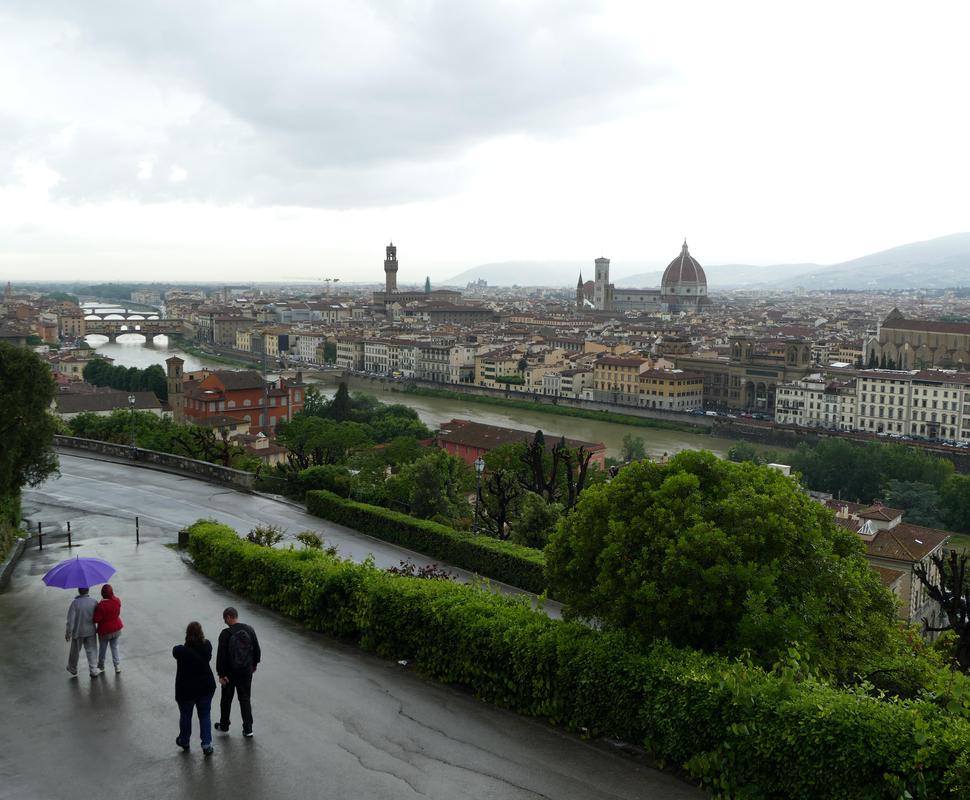
The weather report promised plenty of rain through the afternoon, so I decided I'd rather deal with that in Firenze and Siena was put off for a day. In its place, I decided that the day should be spent in Oltarno (the other side of the Arno river).
My first stop was one of the remaining major churches that I hadn't hit yet, Santo Spirito. There was a small market in the square in front of the church - vegetables, shoes, brassware. But some light rain drove me inside having taken only one or two exterior pictures, and that brought me up against Santo Spirito's "No pictures" rule. That's the first time I've seen that, at least applied to a whole building (I've seen it applied to a single room a couple times). Most places say loud and clear "photography okay, no flash." And often "no tripods" and occasionally "no selfie sticks." I'm okay with all of that, but get a bit pissy about "no pictures." Worse, I'm blanking on the building: I remember the external facade, but not the inside at all. <sigh> Sorry about that.
Palazzo Pitti is an incredibly forbidding bunker of a thing with what amounts to a cemented stone lawn out front. It isn't what you'd call "inviting" ... despite which, large handfuls of tourists sit on the "lawn" anyway, because places to sit are hard to find in Firenze. Pitti is massive, and houses multiple museums. And, by the logic of the time it was built, if you're in the courtyard you're entitled to a pleasing view - it's much nicer than the front. I paid for the combined ticket to the Galleria Palatina and the Galleria Arte Moderna. The Palatina is an immense collection of paintings housed in the former apartments of the Medici: the rooms are gaudy, spectacular, and cause retinal overload all on their own - each has a name and a description and a history, usually with sculpted, painted, and gold-leafed ceilings - although they came in an astounding variety of styles. And then there are the paintings on the walls: the Rough Guide says "an art collection second in importance only to the Uffizi." Now I'm dreading the Uffizi, because the Palatina is incredibly extensive and impressive, representing the entirety of the Renaissance art.
The Palatina collection takes up very large portions of the first and second floors. On the third floor is what they rather oddly refer to as the "Modern" collection: it's "modern" only with respect to the Palatina, with a time period from about 1800 to 1920 - although heavily slanted to the older end of that scale. As is so often the case, the Rough Guide is very close to the mark: "... there's a lot of mediocre stuff here, with ranks of academically proficient portraits, bombastic history paintings and sentimental dross ..." It's one of the things I love about RG: not only do they call it as they see it, I almost always agree with them. Certainly, the Modern collection doesn't compare well to the amazing richness of the Palatina. But it does have a lot of sculptures, and I found some good stuff among those. I went into the Pitti around 1000, came out around 1400. The sun shone while I was in there, the skies opened up about 10 minutes after I emerged - my luck wasn't at its best. I found a local supermarket and bought a slice of pizza and some water: happily, they had a few seats to eat at. They also had a chocolate bar I've been wanting for ages: hazelnut and DARK chocolate. In North America, for some reason, hazelnut is only combined with milk chocolate. I'm not much of a fan of milk chocolate but I do like hazelnuts, so this was a treat.
I headed up the hill to Piazzale Michelangelo through medium rain and light hail (not as bad as it sounds: the pellets were about 3mm and didn't last long). I bypassed the Piazzale because it was still raining, heading further uphill to San Miniato al Monte. That's a strange church: you know split-level houses? It's like that. The organ, church, altar, and pulpit are on the upper level, with all but the pulpit invisible to the main set of pews on the middle level. The middle level also contains a mid-sized tabernacle. And in the lower split is the crypt and another set of pews, presumably for smaller services(?). This was also the darkest church I've been in, by far. Not just because of the clouds outside: very few windows, and maybe three lights in the whole place. There was also a student organist at work for a good part of my visit. My first take on the organ (not the player's fault) was that it sounded like a bullfrog swallowed a harmonica. Definitely a bit on the wheezy side. She (the player) wasn't consistent, but when she hit her stride it actually sounded pretty good and my respect for the organ mostly recovered.
On the way back down the hill I got a better look at Piazzale Michelangelo. It's essentially a huge car park with a brass David surrounded by Day, Night, Dusk, and Dawn (other Michelangelo sculptures from the Medici tombs). The real appeal is the view over Firenze, which is spectacular and definitely worth the trip. By pure luck, my shortest-path-down-the-hill took me straight through the city's rose garden. The roses were almost all in bloom too: it was a nice accidental detour.
I walked all the way out to Ponte San Niccolo at the far eastern end of the tourist zone, then back toward the west via the Oil Shoppe, where I had a #11 panini (smoked prosciutto, caramelized onion, gorgonzola, rucola sauce). It wasn't quite as good as #20. Second-visit let-down? But still a very good sandwich. While I was there, Rush's "Tom Sawyer" was playing on the radio. It's surprisingly comforting to hear a hometown band when you're far from home (and, as I do, you like the song).
photo: Palazzo Pitti museum
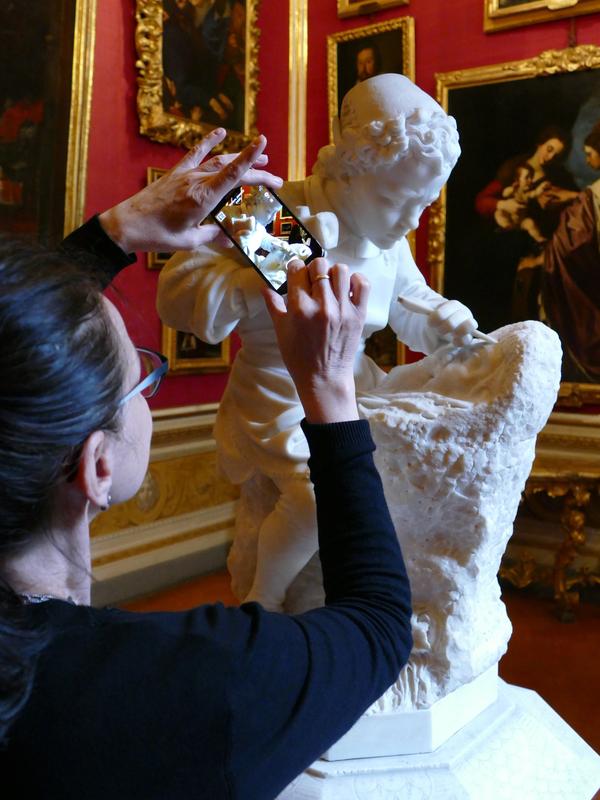
Siena Day Trip
Last night I went back out and had a Negroni at the same small local bar. It's made of Campari and Martini & Rossi, with a smaller quantity of gin, all over ice. I found it simultaneously too bitter and too sweet, as well as more alcoholic than I liked - so not a huge success. I'll stick to the Aperol Spritz.
This morning I went over to the bus station around 0915, only to discover that just because the bus to Siena leaves every 15 minutes in the afternoon doesn't mean it also does so in the morning: the next one was at 1010. I even had the schedule in hand, but I just ... assumed. <sigh> So I spent a bit of time wandering around the square.
Siena offered little to no resistance to the Allies during the Second World War, and is therefore a UNESCO World Heritage site because all the buildings in the town centre haven't changed since medieval times: it's quite lovely, although utterly packed full of tourists. The first place I found my way to was the very large Piazza del Campo, with its big and finely carved fountain, watched over by the Palazzo Comunale and its tower. The Palazzo has a ticket office for a couple of the museums ... and also the Torre del Mangia (tower) that's part of the Palazzo. Which of course I had to climb. Once again, narrow twisty stairs - to the most outstanding view yet. Siena is a low and relatively small town in hilly country, so what you see is a mix of medieval town and gorgeous countryside - and of course the immense Duomo nearby that's high on every tourist's agenda. It's a grand view.
photo: Siena Torra del Mangia bell
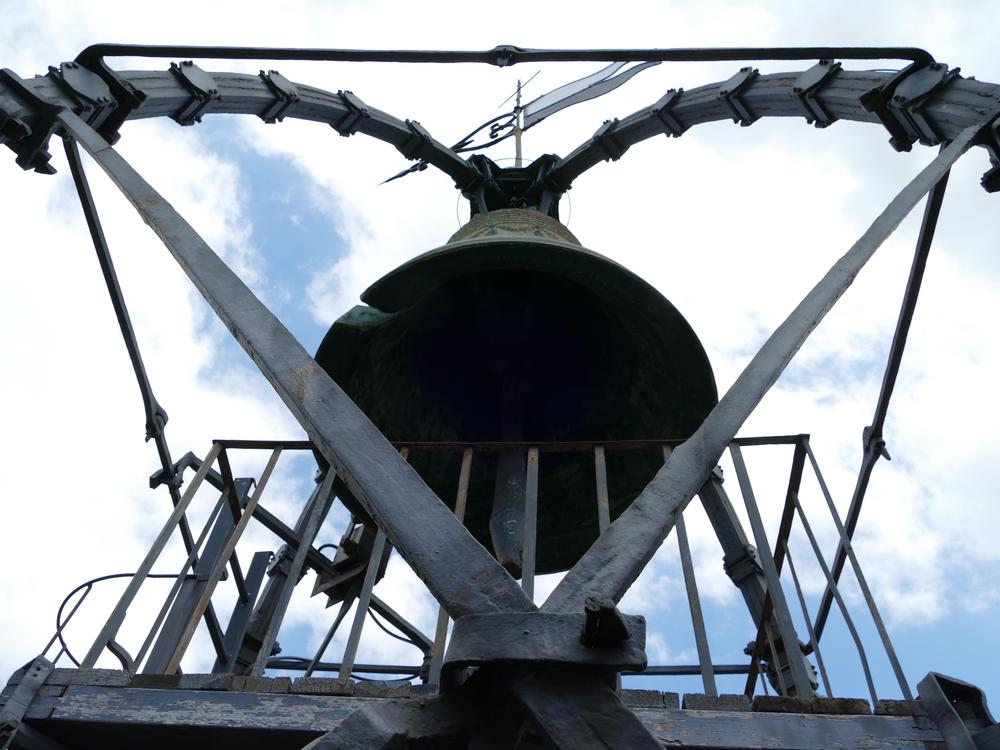
After I hung around there most of an hour, it was time for lunch - and I decided for once to sit down and take it easy, so I went to a place called "Morbidi" - sometime I'll have to look up what that means in Italian, but its English equivalency does kind of amuse me. (Google Translate thinks it means "soft.") The upstairs is a bit of a madhouse, with a large line of people ordering cafeteria-style and packing the tables. For €12 you can trot downstairs into the arched brick basement, where you have a smaller selection on a buffet, but it's much quieter. They had a chickpea and pickled herring salad that was absolutely delicious. I think this is in part due to the style of pickled herring, which is different over here than what we get in North America.
The Duomo is immense - or maybe stripes make it look fat, it wears a similar horizontal white-and-green marble striping to most of the churches in this part of Italy. Not only is it very large, but there's a very tall wall in the same style enclosing part of the square and carpark that indicates where the intended expansion would have gone - making the church rival a football stadium in size. It's already so big ...
I got the "Everything" ticket for €20 because it included the "Porta del Cielo" tour, which was a trot up inside and outside the church at roof level. That was on a timed entry at 1600, so I went into the church first. I was very disappointed to find that the Pisano pulpit was entirely surrounded by hoardings as it was being cleaned. They had pictures of it on the outside of the hoardings, and a few small windows, all of which showed it was very similar to the two I'd seen in Pisa, but they're so outrageous and wonderful I'd really been looking forward to seeing another one.
Every ten or fifteen minutes, a loud and harsh voice would come down from the heavens above: "Silenzio! Silence! No Flash!" Very 1984, although it didn't work terribly well, just grated on the nerves. Certainly not conducive to prayer.
The Rough Guide mentioned that the Capella (chapel) del Voto had two Bernini sculptures! (For those not aware, Bernini is my favourite sculptor - followed by Rodin and Michelangelo.) Oddly, a large hoarding has been erected, fencing off about one quarter of the church, and you have to exit the church and go back in a side door to get to that chapel. But ... there are four sculptures, all uninspired, and I had no idea which was Bernini.
Next up was the Porta del Cielo tour, which started at the main entrance to the church. About 15 of us were ushered in through a hidden door, and up tiny stairs to underneath the roof. Then along narrow passages both inside and outside the church, with grand views both in and out. I would have liked to take it at my own pace, but it's very cramped and it's quite clear why this is a limited and guided tour. Absolutely worth it, and a lot of fun.
Everything was closing at 1800, so I didn't have all that much time left - I still wanted to do the "Panorama del facciatone" tour - up the wall that would have been the exterior wall for the massively expanded church. This should perhaps have been a timed tour like the Porta del Cielo, but was instead a line-up with a 25 minute wait. Then a group of 20 or so people is let in, led through some narrow passages and stairs, and you find yourself standing on top of the wall a good 60 or 70 metres from the main church with wicked views. There's barely room to pass the other people with you, but so much fun and great views. Then back out the same way.
photo: Siena's cathedral shot from the expansion wall

Back out of the building, down around the back, and into the Baptistery: spectacular, but not quite my style. Back out, and in through another door to the crypt - which in this case is more a museum and show of the foundations - which are, as you'd expect, huge.
And my time was up, it was 1800 and everything shut down. <sigh> I had been contemplating taking another bus on to San Gimignano if I had extra time, but that didn't happen.
On an idle wander through the streets of the town, I came across the Chocoshop. I picked up a dark chocolate with candied orange bar for myself, and as soon as I was on the street and had a bite, I went back in to buy another for my co-workers, although I don't think they should get their hopes up about it actually making it back to Toronto without my eating it. If you've ever had Soma's "Old School" chocolate (a bar I've only had once because I never get down to Soma - but man, I remember it well, it was fantastic), it's like that: old style chocolate that's essentially compacted cocoa powder and sugar, not conched to smooth it out as chocolate always is now. The Chocoshop bar has candied orange added to that basic concept. It's slightly too sweet, but the taste is fantastic. I should have bought more.
The bus back was a double-decker, and I was near the head of the line so I managed to snag one of the top front seats. Awesome view all the way back to Firenze.
I took a long walk from the bus station to Gustapizza, highly recommended by one and possibly both of the guidebooks - only to find it lined up out the door, and not in possession of any significant amount of seating, which I wanted after a day of walking. I headed back to the B&B, found a place that seemed okay on the way. I ordered a Aperol Spritz, 500ml sparkling water, and a Calabrese pizza. (I'm pleased to say that Aperol is readily available through the LCBO. Cool.) After about 20 minutes, I asked about my pizza ... and he'd forgotten. But I needed to get up early the next day to go to the Uffizi so I tried to pay ... and he comped my drinks. Which was nice, but I'd rather have had the pizza! I hope to try them again shortly.
The Uffizi and Shopping
photo: A bust in the Uffizi labelled "Leopoldus Cosmae II Medices" (I love it for being too honest)
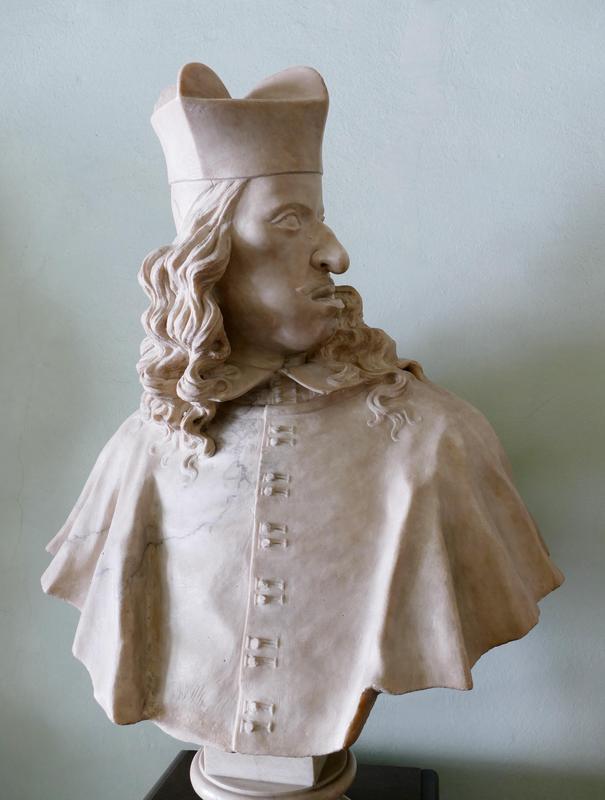
I needed to get to the Uffizi Gallery relatively early this morning, so I left the B&B before breakfast was served and had breakfast instead at Cantinetta Dei Verrazzano: a panchetta and tomato sandwich on a good bun (by which I mean moister/chewier than most Italian bread ...), a cream croissant, a basket full of supplied buns with butter, and a cappuccino.
And then to the Uffizi on my timed-entry ticket, where they noticed my Swiss Army knife in their x-ray of my bag, and politely seized it and gave me a number on a card. After which I trotted up to the second floor (by Canadian standards that's the "third floor" - because here what we call the "first" is the "ground floor" and what they call "the first floor" is what we think of as the "second" ... you get used to it). What confronts you first is a very long corridor of classic Roman sculpture collected by the ever-present Medici family (this was another of their homes, like Pitti Palace). The corridor is also lined by portraits (of the Medicis?) - but as they're only 30x40cm and hung four metres in the air, I suspect most people don't notice. And then there are the rooms. Room after room full of quite possibly the greatest collection of Renaissance Art in the world. Let's just say they have "The Birth of Venus" by Botticelli ( https://en.wikipedia.org/wiki/The_Birth_of_Venus_%28Botticelli%29 ) and I leave it to you to imagine what it means that they have dozens more in that class. I think my brain is adjusting to continual sensory overload - I'm not sure if that's good or bad. I was pleased to see another copy of "Laocoön and His Sons" - which I've come to realize is one of the seminal Renaissance sculptures, and all the more impressive for being Roman ( my picture from Rome ). It was hugely influential in that period. When you get done the second floor (it only took me two hours ... I'm not claiming that's a good thing), you realize you still have "the foreign painters" on the first floor. You know - minor stuff like Rembrandt? Although I got through that floor faster, in part because a large chunk of it is currently occupied by a lot of that gold-leaf religious icon art that I'm not entirely keen on. So yes, a pretty impressive museum.
I board a flight unpleasantly early on Monday morning, which means that today was shopping day. The problem being that most stores aren't open on Sunday, so if I wanted anything, I had to buy it today.
My first stop was the Scuola del Cuoio, or "School of Leather" (I think). Where leather workers train, and where they sell the products they create. Not perhaps as cheap as I'd hoped, but the products for sale in the store were of good quality. I ended up buying a belt for €39. Very plain, black. One would hope also of very high quality.
On the way there, I spotted the "Beer House Club," which is doing its best to be a artisanal beer pub. I didn't want a drink at the time, but carefully noted it on my map.
From the Scuola I visited the church it's attached to, Santa Croce (my Italian is pretty weak, but this seems to translate as "Saint Cross." Google Translate gives me the more likely "Holy Cross"). Very large church - although I have to admit that my scale has shifted having seen particularly Siena's Duomo. So - "very large," not "huge." The place is utterly littered with graves, both on the floor and on the walls (their brochure claims 270 of them). Toward the front and the chapels, you essentially can't walk without stepping on a grave marker. And the ones on the walls include a number of very famous worthies, including (just ones I noticed myself) Marconi, Macchiavelli, and Rossini. The building also has two utterly gorgeous cloisters, although sadly the larger of the two is partly covered for renovation.
photo: The Santa Croce cloister
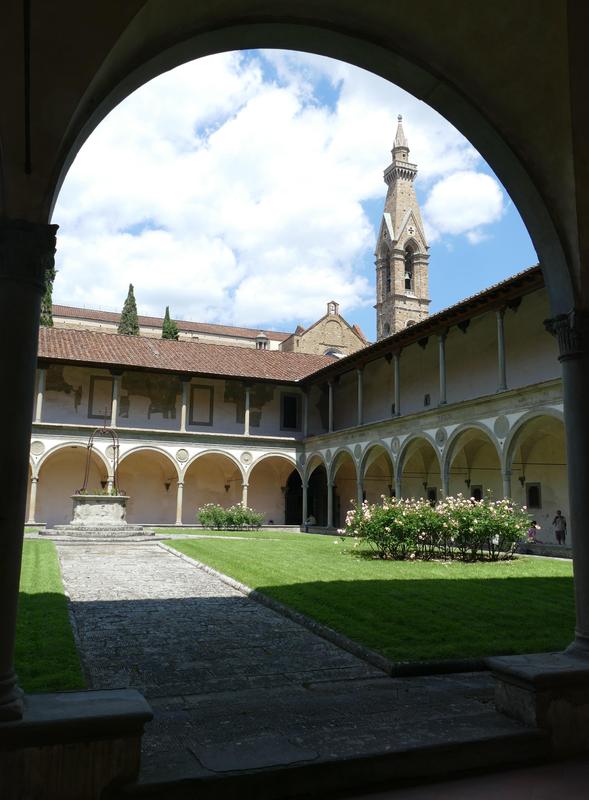
I rushed back to Alberto Cozzi for 1500, because they said there would be a demonstration of paper marbling ... but: "my brother-in-law is not here, can you come back at 1600? We aren't sure he'll be here at all ..." I ended up choosing three sheets of marbled paper to add to the five I already have from Venice. They packed them up in a shipping tube for me. I returned at 1630 - Cozzi never showed, and the woman sounded kind of pissed - they actually had a customer who wanted to see the demo ...
I trotted on over to St. Trinitas, which was - as my guidebook had claimed - open, but was in the midst of a service. So I moved on without visiting. I went back to Riva d'Arno (yesterday's pizza place) where I had an Aperol Spritz - and this time actually got my Calabrese Pizza. Which was in fact quite good. And then another Aperol Spritz - which was perhaps unwise given my next destination.
I found my way to Beer House Club, where the bartender recommended Brewfist's "X-Ray Imperial Porter," as I was asking after dark Italian beers. These aren't a common thing: Italy has Moretti and Peroni, both relatively light beers, and the stuff in the mini-marts pretty much stops there. So I was pleased to find any dark beers at all in this wine-obsessed country. As it turns out, quite a nice porter. I'll spare you my attempts to describe it, beyond saying it was a fairly classic Imperial Porter and it was 8.5% alcohol (although it didn't taste strong). I should have left it at that because he didn't have anything else that was dark and Italian, but I was interested in the Kloster-Scheyern "Kloster-Dopplebock Dunkel," so I had that too (7.4%, "500cl). He mentioned "coffee," but what I got from tasting it was "HONEY."
From there I went to Piazza della Signoria at dusk. A zoom lens is a wonderful thing for taking pictures of people who have no idea you're even in the square with them. We'll see if any of the pictures are actually any good.
The last stop of the day was La Carraia, a gelato place in Oltarno (although barely - you just cross the bridge and you're there). Nothing beats dark chocolate and lemon. Yum.
At night, most Italian businesses shutter themselves. Gray metal industrial rolling doors, it makes streets look really grim.
Tomorrow is my last day! I'm very sad.
photo: One of the many comedy no-entry signs I photographed across the city
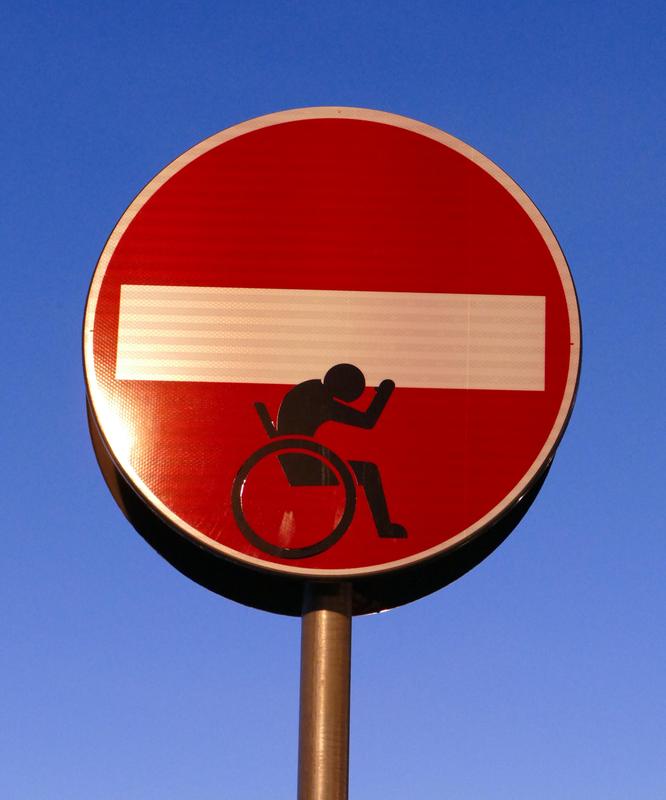
Last Day
photo: Just because you're on your horse you shouldn't be disconnected from modern conveniences ...
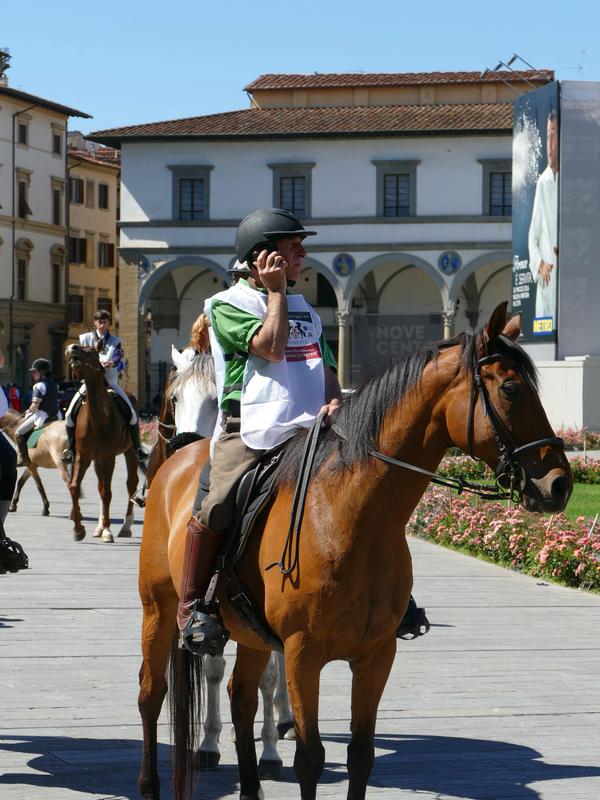
The first stop of the day was St. Trinita, which had been having a service when I'd tried to enter on Saturday evening. So now, early Sunday morning, I got in without trouble. The front doors are wonderfully carved wood.
At Ognissanti (one of the closest churches to my B&B, but a relatively small one that I hadn't visited yet) there was a service, so that had to be put off.
Palazzo Medici-Riccardo was owned, as you might suspect, by the Medicis. And later the Riccardo family, whose eventual financial ruin left this rather nice palazzo to the state. For the most part, it's a sequence of attractive period rooms. The stand-out is the small chapel, which was painted in considerable detail on four walls and the ceiling by Benozzo Gozzoli. The courtyard is also quite lovely, although it - like several cloisters I've seen - is half covered for renovation.
The San Marco church was most memorable for its organist: I don't know what he was playing, but I really enjoyed it. I have to suspect that he was doing some well-translated piece of 60s or 70s rock rather than liturgical music. Sadly, he was only at it for a couple minutes.
photo: San Marco Church

Attached to San Marco is its "Museum," which is more the former monastery and its cloisters. But it's most famous because there are 43 monk's cells - every single one of which was decorated by Fra' Angelico, one of Italy's most famous Renaissance painters who was himself a monk (although he later married a nun and left the order). San Marco was also the home and headquarters of the notorious Girolamo Savonarola. If the name doesn't sound familiar, perhaps the term "Bonfire of the Vanities" is (apparently it wasn't singular - there were several). Savonarola was hugely influential in Firenze circa 1490, where he convinced many people that worldly goods (particularly scandalous stuff like nude paintings, but also many other expensive trinkets) were not only unnecessary, but an impediment to entry into heaven. So a huge bonfire was made in one of the main squares - and a lot of great Renaissance art works were lost. His rule lasted about a decade, before he too - like the vanities - was burned (after being hanged).
Then came the very long walk in search of lunch - I think I need a sherpa. The Central Market was packed full so I passed, and the Oil Shoppe isn't open on the weekends. I found another specialty beer bar, but they seemed to have only imports, barely anything domestic. It was interesting to notice that the primary language spoken among the guests there - as well as at Beer House Club - seemed to be English. There are a LOT of tourists in Florence, but English isn't particularly common in general (I'd say a quarter of the tourists are Italian). I finally tramped on over to Oltarno and went to Enoteca Fuori Porta, where I had a glass of Chianti Classico with a brilliant potato ravioli with rabbit ragu - probably the best meal of the trip. As I was in a wine and liquor bar, I followed it up with Rapa Giovanni Moscato Reserva Grappa (from Piemonte?): my waitress had recommended it when I asked after grappa, saying it was "smooth:" I wouldn't particularly say so. Mild but distinct licorice flavour, served in a very accentuated thistle glass. Still didn't convince me I needed to bring any grappa home, although it was interesting.
Very near there, by good fortune I came across the source of the comedy "No Entry" signs I've been photographing all across Firenze. The first one I saw had a standard "No Entry" sign (at the wrong end of a one-way street) modified to show a sumo wrestler struggling with the white bar. There are dozens of variants, and they've also modified some other street signs (they generally remain serviceable for their purpose). It's been an amusing pursuit photographing them as I went around the city. So I bought four stickers of these signs, each about 10cm in diameter. I'm sure one will end up on my laptop.
The Santi Apostoli church proved hard to find: I eventually made my way to the justly named Piazza del Limbo - it's a well-hidden dead end off a relatively obscure street. For all that, I wasn't sure why Rough Guide had sent me there: it was a small and not terribly interesting church.
Ognissanti on the other hand ... that was my last tourist stop on the entire trip (unless you count dinner). And it was a pleasant surprise: not only a more interesting church in general, but it also had a trompe-l'oeil ceiling. This time, the short ends of the main ceiling had seating galleries, from which angels looked down upon us. I love the visual tricks, and a good trompe l'oeil painting is always a lot of fun.
photo: Ognissanti trompe-l'oeil ceiling
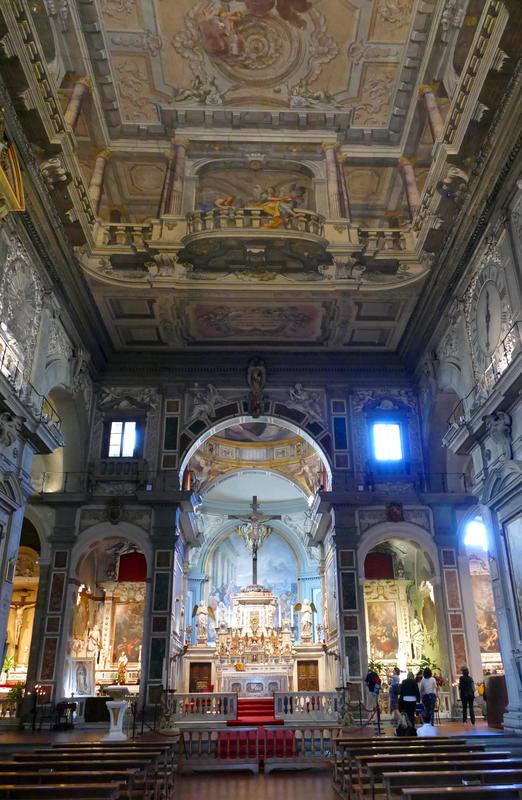
1730 Sunday evening is a poor time to try to track down a meal in Firenze: most restaurants open at 1900 or 1930 even during the week (and even if they serve lunch: most close from 1500 to 1900), but many are closed entirely on Sunday. I ended up back at Riva d'Arno, on their street-side patio watching the Ponte alle Carraia traffic (Carraia bridge over the Arno), and the business from the even-busier-than-yesterday Carraia gelato shop. Repeat business must be relatively rare in Firenze: I was welcomed back both at Riva d'Arno and the Oil Shoppe (or maybe Italians are better at remembering their customers). I had an Aperol Spritz and a "Gustapizza:" cherry tomatoes, rucola, parmesan, and mozzarella. Rucola, as it turns out, is a bitter salad green (they used lots) and BIG hunks of parmesan - it was very good.
So a good end to a good trip: early to bed for a painfully early flight, and I'll be back in Toronto Monday afternoon.
Post Script: The Rome duty free provided me with a bottle of Aperol (the LCBO has it, but this was much cheaper) and a bottle of Pallini Limoncello (the Pallini is the best big commercial limoncello I've found so far - available all around the world, but not in Toronto <sigh>).